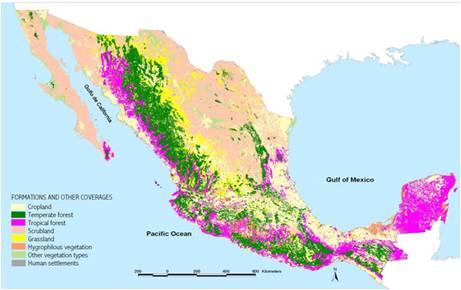Mexique
Date de mise à jour : 17 février 2012
In Mexico, PES programs have the primary goal to create incentives for forest conservation as the country is undergoing rapid processes of land cover change with rates of deforestation of 0.25 and 0.76 % per year during the last decades for temperate and tropical forests respectively (Velázquez et al. 2002, Mas et al. 2002).
Today, almost 30% of the country area (55.3 M ha) is covered by diverse types of forests (Figure 1) which are providing various social, economic and ecological benefits. For instance, Mexico is one of the five biologically richest countries. Just to mention about tree diversity, it is home to 50% of all known pine species and of 135 species of oak. In addition, forests have an important role in protecting watersheds in this country suffering increasing levels of water shortage, with 15% of aquifers seriously overexploited.
Figure 1. Mexico forest cover. Forest inventory 2000.
This water service is targeted by the Payments for Hydrological Environmental Services (PSA-H) which is the instrument of focus in this case study. This program administered at the national level by the National Forestry Commission (CONAFOR) is the largest PES program in Mexico, covering 1,5 million ha of tropical temperate and cloud forest and counting 2 000 participants (500 ejidos).
The research objective is to assess the impact of the PSA-H in line with the other instruments it is interacting. The work will be done on a multiscaling –from national to regional and local level, and multimatching basis –impact assessment comparison of pairs of sites and of similar user groups among sites.
Date de mise à jour : 17 février 2012

